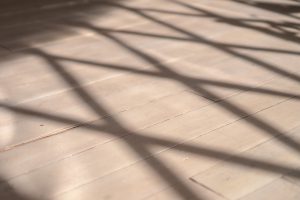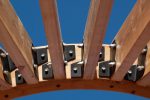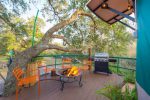Safety and Security
Main specs for American yurt companies (organized alphabetically). Updated December 2019. Pacific Yurts declined to provide information for this website.
Yurt Company Acronym Key
- BR = Blue Ridge Yurts
- CY = Colorado Yurt
- GL = Great Lakes Yurt Co
- LI = Living Intent Yurt Co
- NS = Nomad Shelter
- RO = Rainier Outdoor
- SD = Shelter Designs
- YA = Yurts of America
Company Contact
| Company | Website | Phone Number | |
|---|---|---|---|
| BRBlue Ridge Yurts | blueridgeyurts.com | [email protected] | (540) 745-7458 |
| CYColorado Yurt | coloradoyurt.com | [email protected] | (800) 288-3190 |
| GLGreat Lakes Yurt Co | greatlakesyurtco.com | [email protected] | (269) 808-3664 |
| LILiving Intent Yurt Co | livingintentyurts.com | [email protected] | (207) 350-9457 |
| NSNomad Shelter | nomadshelter.com | [email protected] | (907) 235-0132 |
| RORainier Outdoor | rainieroutdoor.com | [email protected] | (866) 483-6795 |
| SDShelter Designs | shelterdesigns.net | [email protected] | (406) 721-9878 |
| YAYurts of America | yurtsofamerica.com | [email protected] | (317) 377-9878 |
Company Details
| Company | Location | Year First Yurt Sold | Tour Available? |
|---|---|---|---|
| BRBlue Ridge Yurts | Floyd, VA | 2004 | |
| CYColorado Yurt | Montrose, CO | 1980 | |
| GLGreat Lakes Yurt Co | Grass Lake, MI | 2017 | — |
| LILiving Intent Yurt Co | Grass Valley, CA | 2015 | |
| NSNomad Shelter | Homer, AK | 1987 | |
| RORainier Outdoor | Tukwila, WA | 2004 | |
| SDShelter Designs | Missoula, MT | 2005 | |
| YAYurts of America | Indianapolis, IN | 1986 | — |
Yurt Info
| Company | Available Sizes | Max Snow Load* | Base Cost of 30' | Base Cost of 16' |
|---|---|---|---|---|
| BRBlue Ridge Yurts | 16', 20', 24', 30' | 60 psf | 60 psf | $13,047 | $7,299 |
| CYColorado Yurt | 16', 20', 24', 27', 30' | 15 psf | 95 psf† | $12,240 | $7,090 |
| GLGreat Lakes Yurt Co | 16', 20', 24', 27', 30' | 75 psf | 75 psf | $11,000 | $5,000 |
| LILiving Intent Yurt Co | 12', 14', 16', 20' | — | — | $6,000 |
| NSNomad Shelter | 12', 16', 20', 24', 30', 34', 40', 50' | 60 psf | 60 psf | $15,500 | $8,000 |
| RORainier Outdoor | 16', 18', 21', 24', 27', 30', 33' | 100 psf | 105 psf† | Eagle: $18,820, Raven: $13,358 | Eagle: $9,466, Raven $7,426 |
| SDShelter Designs | 12', 16', 20', 24', 27', 30', 35', 40' | 40 psf | 150 psf | $12,480 | $6,760 |
| YAYurts of America | 12', 14', 16', 20', 30' | 60 psf | 95 psf | $12,000 | $6,499 |
*(30' yurt without upgrades | 30' yurt with all upgrades), †Site specific engineering available for higher snow loads
Rafter Details
| Company | Wood Species | Base Rafter Size for 30' |
|---|---|---|
| BRBlue Ridge Yurts | Spruce | 2x6 |
| CYColorado Yurt | Doug Fir | 2x4 |
| GLGreat Lakes Yurt Co | Doug Fir | 2x6 |
| LILiving Intent Yurt Co | Doug Fir | — |
| NSNomad Shelter | Spruce | 2x6 |
| RORainier Outdoor | Doug Fir | 2x6 |
| SDShelter Designs | Western Tamarack (Larch) | 2x6 |
| YAYurts of America | Southern Yellow Pine | 2x6 |
Lattice Details
| Company | Wood Species | Lattice Thickness | Base Height of Wall |
|---|---|---|---|
| BRBlue Ridge Yurts | Poplar | 3/4" | 7' 4" |
| CYColorado Yurt | Doug Fir | 1/2" | 7' 2" |
| GLGreat Lakes Yurt Co | Doug Fir | 1/2" | 7' 4" |
| LILiving Intent Yurt Co | Bamboo | 1/2" | 6' 9" |
| NSNomad Shelter | Spruce | 7/8" | 7' |
| RORainier Outdoor | Doug Fir | 3/4" | 7' 4" |
| SDShelter Designs | Doug Fir | 7/16" | 7' 2" |
| YAYurts of America | Poplar | 3/4" | 7' |
Available Upgrades
| Company | Insulation |
Thick Roof Cover |
French Doors |
SIP Panels |
Glass Windows |
Awnings |
Rain Diverter |
Opening Dome |
Tinted Dome |
Water Catchment |
Wind & Snow Package |
10ft Walls |
Swappable Walls |
|---|---|---|---|---|---|---|---|---|---|---|---|---|---|
| BRBlue Ridge Yurts | — | — | — | ||||||||||
| CYColorado Yurt | — | — | — | ||||||||||
| GLGreat Lakes Yurt Co | — | — | — | — | — | — | — | — | — | — | |||
| LILiving Intent Yurt Co | — | — | — | — | — | — | — | — | |||||
| NSNomad Shelter | — | — | — | — | — | — | — | — | — | — | — | ||
| RORainier Outdoor | — | ||||||||||||
| SDShelter Designs | — | — | |||||||||||
| YAYurts of America | — | — |
Final Details
| Company | Lead Time | Shipping Available | Financing Available | On-site Construction Services | International Purchasing |
|---|---|---|---|---|---|
| BRBlue Ridge Yurts | 3-4 weeks | — | — | ||
| CYColorado Yurt | 5-8 weeks | ||||
| GLGreat Lakes Yurt Co | 6-8 weeks | — | — | ||
| LILiving Intent Yurt Co | 7 weeks | — | |||
| NSNomad Shelter | 6-12 weeks | ||||
| RORainier Outdoor | 3-7 weeks | ||||
| SDShelter Designs | 4-6 weeks | — | |||
| YAYurts of America | 2-5 weeks |
Storms and Weather
As mentioned previously, the yurts inherent shape were specially made for inclement weather. The round structure diverts wind around while the rafters and lattice walls evenly distribute the weight of snow down to the ground. However, the variability in a yurt’s effectiveness to combat the weather will vary drastically from kit to kit and company to company. Most American yurt companies will have their yurts tested to get strength ratings that will tell you how their yurt will perform in extreme conditions. Rainier’s 30ft base yurt has a snow load of 100 psf (pounds per square foot) while other companies will be around 15-20 psf. You can buy and build additional upgrades like vertical studs or even a metal center column that can increase the strength of a yurt drastically up to around 250 psf.
Basic thunderstorms and snowstorms should be no problem for a properly built yurt, but like all houses there are limits. Hurricanes and tornadoes will likely damage a yurt despite some anecdotal evidence saying otherwise.
Animals
The allure of yurts is that it encourages a closer relationship with the environment where it is built. This is one benefit of yurts that can actually become quite problematic. The mountains or forests surrounding a yurt can introduce the local wildlife to your humble home. While the relatively harmless rodent can be dealt with in any number of ways, there are larger and more dangerous animals to be wary of. In the American Southwest snakes are not uncommon while in other areas, bears may be a possible intruder. There are only so many things you can do to combat these potentially deadly animals from breaking into a yurt and much of it comes down to prevention.
By building a yurt on an elevated platform, you’re making it much more difficult for smaller animals to sneak, slip or slither inside. Larger animals like bears are more difficult to control. If you live in a bear-prone area, the thin vinyl on the outside of the yurt will do little to stop a hungry bear. The lattice may keep all but the most tenacious of the Ursidae family outside. You’re best bet is to not incentivize the bear from coming in by removing the tempting smells of food. Keep your food in a bear-proof container separate from the yurt. Additionally, consider installing an electric fence, motion-sensing lights and/or various noisemakers. Whatever you do, regular maintenance and proper construction will help prevent and catch problems with wildlife intruders.
Crime
There’s another type of intruder that comes in the form of a human. The reality is that if a potential criminal wants to come inside your home, they will find a way regardless of what type of structure you’re dealing with—yurt, cabin, treehouse, etc. All you can do is make a little harder for them to do. Many ways to do that is similar to what you would do for animals or a normal house in the city. Most yurt companies will offer doors that lock. If you’re able to use electricity you could install an alarm system or motion-activated lights.
These are all solutions to potential problems, but the best way to prevent having to deal with a problem like this is to carefully consider where you are building your yurt. Is the area known to have a low crime rate? Does your property have a gate that would make it more difficult for unwanted vehicles to come in and out? These are all things that should be thought about thoroughly.
Previous Chapter

Choosing a Yurt Company
Next Chapter



